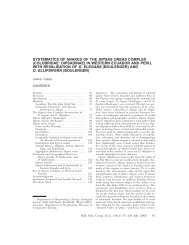cryptic species within the dendrophidion vinitor complex in middle ...
cryptic species within the dendrophidion vinitor complex in middle ...
cryptic species within the dendrophidion vinitor complex in middle ...
Create successful ePaper yourself
Turn your PDF publications into a flip-book with our unique Google optimized e-Paper software.
SPECIES IN THE DENDROPHIDION VINITOR COMPLEX N Cadle 223<br />
Figure 20. Everted hemipenis of Dendrophidion apharocybe (LACM 148600 from near <strong>the</strong> type locality, left hemipenis) <strong>in</strong><br />
sulcate, asulcate, and lateral views. Note flared tip of <strong>the</strong> sulcus spermaticus and <strong>the</strong> nude apical tip strongly <strong>in</strong>cl<strong>in</strong>ed toward <strong>the</strong><br />
sulcate side (sulcate to <strong>the</strong> right <strong>in</strong> lateral view).<br />
<strong>the</strong> sulcate side. Some small sp<strong>in</strong>es are<br />
<strong>in</strong>corporated <strong>in</strong>to <strong>the</strong> first flounce on <strong>the</strong><br />
sulcate side. On <strong>the</strong> sulcate side all sp<strong>in</strong>es<br />
are more or less <strong>the</strong> same size (perhaps<br />
slightly larger proximally). On <strong>the</strong> asulcate<br />
side, <strong>the</strong> distal sp<strong>in</strong>es are slightly larger than<br />
<strong>the</strong> more proximal ones.<br />
Four flounces on <strong>the</strong> sulcate side broaden<br />
to about seven on <strong>the</strong> asulcate side. The<br />
proximal flounce on <strong>the</strong> sulcate side becomes<br />
<strong>the</strong> 3rd flounce on <strong>the</strong> asulcate side<br />
(two proximal flounces added on <strong>the</strong><br />
asulcate side). Flounces curve distad toward<br />
<strong>the</strong> asulcate side, reflect<strong>in</strong>g <strong>the</strong> <strong>in</strong>cl<strong>in</strong>ation<br />
of <strong>the</strong> apex toward <strong>the</strong> sulcate side (Fig. 20,<br />
lateral view). No dist<strong>in</strong>ct calyces except for a<br />
couple of irregular ones distally on <strong>the</strong> right<br />
asulcate side (i.e., <strong>the</strong> right side viewed<br />
look<strong>in</strong>g toward <strong>the</strong> asulcate side; see<br />
Fig. 20, asulcate view). These calyces are<br />
asymmetrical (no comparable ones on <strong>the</strong><br />
left side). Several o<strong>the</strong>r weak calyces<br />
present between <strong>the</strong> first pair of flounces<br />
on <strong>the</strong> asulcate side (weakly developed<br />
longitud<strong>in</strong>al walls between <strong>the</strong>se two flounces).<br />
Flounces have a thick fleshy base and an<br />
outer membranous part. All flounces have<br />
embedded sp<strong>in</strong>ules, <strong>the</strong> tips of which<br />
occupy weak scallops on <strong>the</strong>ir edges;<br />
sp<strong>in</strong>ules occupy ma<strong>in</strong>ly <strong>the</strong> membranous<br />
part but enter <strong>the</strong> fleshy part slightly.<br />
Scallop<strong>in</strong>g becomes progressively less distally<br />
and medially.<br />
Apex strongly <strong>in</strong>cl<strong>in</strong>ed so that its distal<br />
surface faces toward <strong>the</strong> sulcate side<br />
(flounces extend<strong>in</strong>g distad much far<strong>the</strong>r on<br />
<strong>the</strong> asulcate than <strong>the</strong> sulcate side). Central<br />
part of <strong>the</strong> apex occupied by a prom<strong>in</strong>ent<br />
bulge, which slopes gradually to meet <strong>the</strong><br />
asulcate edge of <strong>the</strong> apex but drops off<br />
sharply on <strong>the</strong> sulcate side (Fig. 20, lateral<br />
view). The sulcus ends near <strong>the</strong> sulcate side<br />
of <strong>the</strong> organ just beneath <strong>the</strong> bulge. Apex<br />
nude except for low rounded ridges that<br />
occupy <strong>the</strong> central bulge. These ridges have<br />
<strong>the</strong> same general pattern as <strong>the</strong> membranous<br />
ridges on <strong>the</strong> hemipenis of D. <strong>v<strong>in</strong>itor</strong><br />
(see above description). That is, <strong>the</strong>y extend<br />
obliquely outward toward <strong>the</strong> asulcate side<br />
from a median axis; toward <strong>the</strong> sulcus <strong>the</strong><br />
Bullet<strong>in</strong> of <strong>the</strong> Museum of Comparative Zoology harv-160-04-01.3d 11/4/12 19:59:51 223







